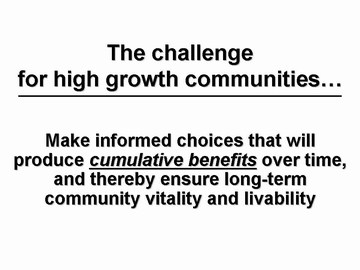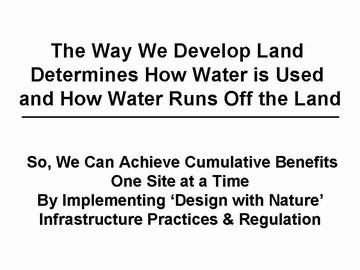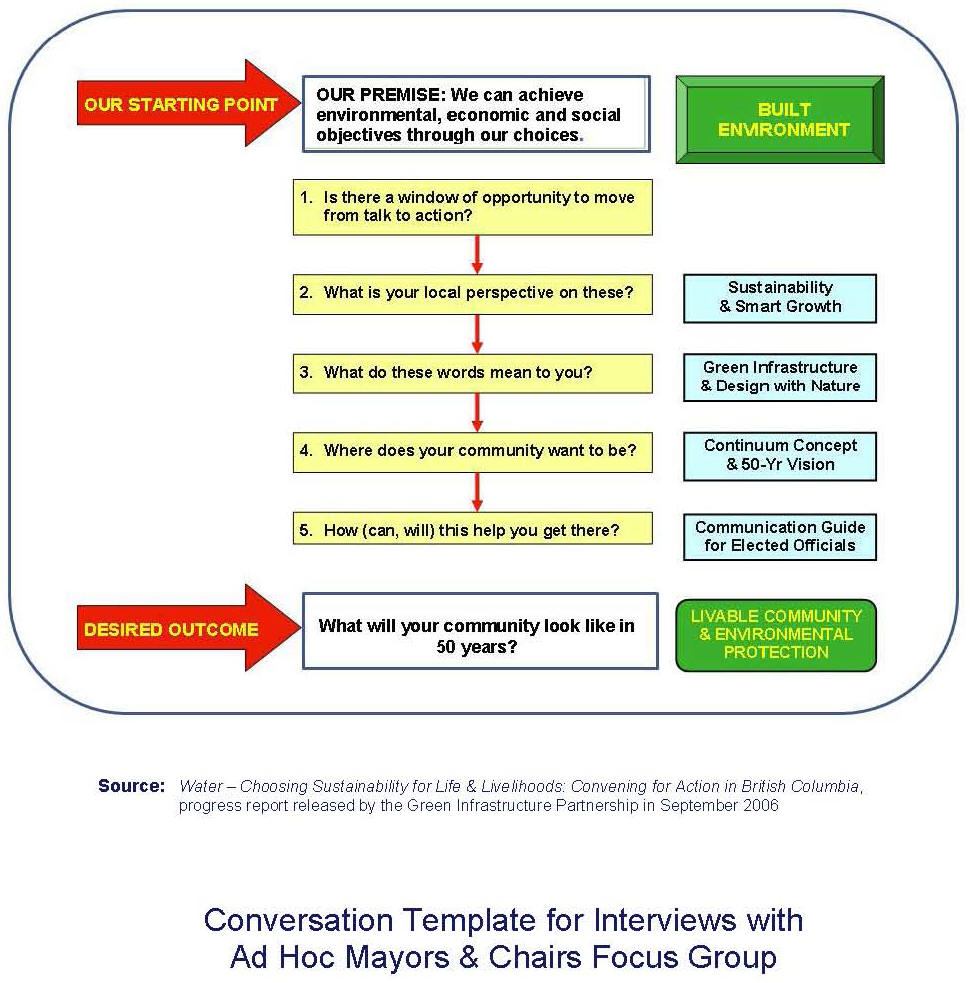Soft Path to Water-Centric Sustainability: Conversations with Elected Officials

CONTEXT
Sustainability is a buzzword. We hear it daily…but what does it mean in the community context? The Building SustainAble Communities conference, organized by Joanne deVries and held in the City of Kelowna, was designed to address these questions:
- What are the social, environmental, and economic benefits of building sustainable communities?
- What are the barriers to achieving a sustainable community?
- How can local governments actually save money and promote economic activity while protecting human and environmental health?
- What sustainability models have been used successfully, and where?
- What best practices and legislative tools are being used, and how?
- What do citizens think and how can you engage them in the move towards sustainability?
- How can you move from idea to implementation?
- What’s available in the way of senior government planning and funding support?
- And, is sustainability politically survivable?
World-renowned experts, such as Bill Rees of ‘ecological footprint’ fame, use a complementary blend of plenary sessions, facilitated table exercises, and breakouts to help participants answer these questions in a meaninful, memorable, and motivational way.
To Learn More:
For complete information on the conference program and speaker line-up, please click on this link to Program for November 2006 Building Sustainable Communities Conference
CONVERSATIONS WITH ELECTED OFFICIALS
The Building SustainAble Communities conference provided a timely opportunity for the Green Infrastructure Partnership and Water Sustainability Committee to provide a progress report on what is being learned through one-on-one conversations with an ‘ad hoc mayors and chairs focus group’ that has representation from three regions.
Interviews are being conducted by Kim Stephens, Program Coordinator for the Water Sustainability Action Plan for British Columbia. The interviews are a prelude  to creating a Green Infrastructure Communication Guide for Elected Officials. “Elected officials are being bombarded with information on any number of issues,” said Stephens, “In having one-on-one conversations about green infrastructure, my objective was to see the world through the eyes of elected officials. That is an important first step in figuring out how to translate technical information into a form that elected officials can readily absorb so that they can make informed decisions.”
to creating a Green Infrastructure Communication Guide for Elected Officials. “Elected officials are being bombarded with information on any number of issues,” said Stephens, “In having one-on-one conversations about green infrastructure, my objective was to see the world through the eyes of elected officials. That is an important first step in figuring out how to translate technical information into a form that elected officials can readily absorb so that they can make informed decisions.”
Conversation Template
To ensure a consistent approach to the one-on-one conversations, Stephens developed what he called a Conversation Template. “My approach is based on listening to them rather than talking at them,” explained Stephens, “Before we can write a Communication Guide, we need to understand what elected officials already know plus what they would like to know about green infrastructure. Only then can we judge what level of information transfer will be useful to them. The interviews are yielding insights that will help us determine how we can be clear and compelling in conveying key messages in the proposed Communication Guide.”
The starting point for interviews is the premise that we can create our future, and the decisions that elected officials make ripple through time. Stephens points out that those decisions can result in either cumulative impacts or cumulative benefits: “In recent decades, communities have typically been experiencing cumulative impacts. The desire to mitigate those impacts has provided the driver for the green infrastructure movement across North America and elsewhere. Looking ahead, the challenge is to make informed choices that produce cumulative benefits and thereby ensure community livability.”
To Learn More:
To download a copy of the template, please click on this link to Conversation Template for Interviews with Elected Officials

Overview of Key Findings
The focus of the interviews is on the Built Environment, with emphasis on what can be achieved in the suburban communities. Because our actions determine what the Built Environment will look like, interviewees are asked to visualize their communities in 50 years. “I point out that 50 years is one building cycle,” said Stephens, “This provides a reality check on what can be done in newly developed areas. Basically, it is a missed opportunity because communities will have to wait for the next building cycle to do things materially different. As and when older areas are redeveloped, on the other hand, redevelopment creates opportunities to design with nature and achieve a vision for communities in balance with water.”
According to Stephens, “What we have learned to date is not unexpected. Rather, it is more a case of validation of what was becoming increasingly apparent as the interviews unfolded.” Reflecting on what he has heard during his conversations with elected officials, his over-arching findings across the three regions are synthesized as follows in terms of each element of the Conversation Template:
- The Built Environment: The winds of change that apparently characterized the November 2005 municipal elections have raised expectations that there will be a change in the way land is developed in British Columbia. Growth regions are at a crossroads: Will further settlement be in balance with ecology, or not?
- Sustainability and Smart Growth: These terms are abstract and over-used, and there is a disconnect between what people say and what they do in practice. Without on-the-ground examples that clearly demonstrate ‘how to do it’, the public will soon tune out.
- Green Infrastructure & Design with Nature: Green infrastructure is not fully understood, but is seen as water-centric: In the Okanagan, green infrastructure is associated with the use of water and sustainability of supply; whereas in the Greater Vancouver region and on Vancouver Island, it is associated with control of water that runs off the land and sustainability of aquatic habitat. Design with nature resonates because people intuitively ‘get it’; furthermore, it is equated with resiliency in addressing uncertainty.
- Continuum Concept & 50-Year Vision: While many elected officials may not have a long-term view, they do understand the need for a vision. Instant gratification is the barrier to acting long-term. There is a pressing need for short-term successes to create momentum and build support for long-term action.
- Green Infrastructure Communication Guide: Three words say it all: language, language, language. Sound bites are powerful. Be succinct and straightforward. Use layman language. Provide examples. The conversation process is as important as the eventual Guide product, and perhaps more so. Conversations about ‘designing with nature’ are creating awareness that in turn can have a domino effect in sparking other conversations when elected officials convene.

To Learn More:
To download the presentation by Kim Stephens, please click on this link to Soft Path to Water-Centric Sustainability: Conversations with Elected Officials.
For the complete story, please click on this link to the September 2006 progress report titled Water – Choosing Sustainability for Life & Livelihoods: Convening for Action in British Columbia .


